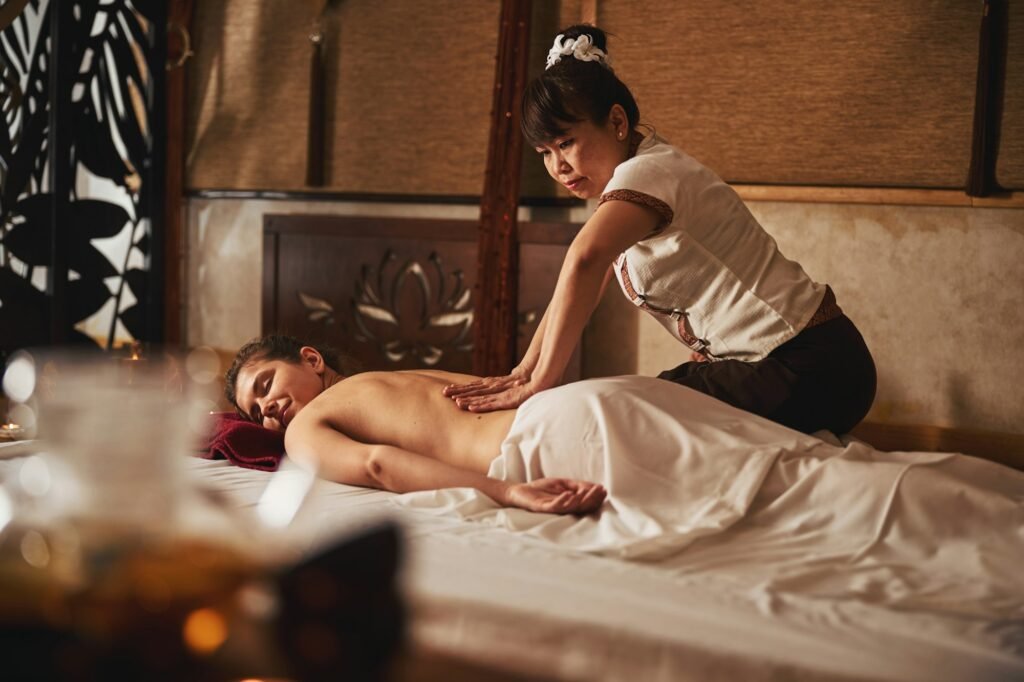Effleurage

Effleurage
What is Effleurage?
Effleurage is a core massage technique characterized by long, smooth, and flowing strokes applied with gentle to moderate pressure. Typically performed with an open palm or fingertips, Effleurage movements glide along the body in the direction of blood flow toward the heart. It is a fundamental component of Swedish massage and various other relaxation-focused massage modalities.
How Can Effleurage Help You?
Effleurage offers numerous ways to support both physical and mental well-being:
- Muscle Relaxation: The gentle, rhythmic strokes of Effleurage help soothe tense muscles, reduce tightness, and promote relaxation.
- Stress Relief: Effleurage helps induce a state of calm, reducing stress levels and promoting a sense of peace.
- Improved Circulation: Effleurage may stimulate blood flow and lymphatic drainage, aiding in detoxification and circulation.
- Pain Management: While not its primary focus, Effleurage can help diminish pain and promote relaxation in areas of discomfort.
- Holistic Wellness: Effleurage encourages a deeper mind-body connection, offering a sense of overall well-being.
What is Effleurage Good For?
Effleurage is a versatile technique beneficial in various contexts:
- Swedish Massage: Effleurage is a central element of Swedish massage, used for relaxation and soothing muscle tension.
- Therapeutic Massage: Effleurage often begins and ends massage sessions, creating transitions and promoting a sense of relaxation.
- Sports Massage: Effleurage can aid in warm-up before athletic activity and muscle recovery afterward.
- Self-Massage: Simplified Effleurage techniques can be incorporated into a self-care routine for relaxation.
- Well-being Ritual: The soothing nature of Effleurage makes it a lovely addition to general well-being practices.
Benefits of Effleurage
Effleurage provides a multitude of benefits for the body and mind:
- Reduced Muscle Tension: Helps alleviate muscle tightness, soreness, and stiffness, promoting comfort.
- Enhanced Relaxation: Calms the nervous system, reducing stress and promoting feelings of tranquility.
- Boosted Circulation: May potentially improve blood flow and lymphatic drainage, benefiting overall health and contributing to more radiant-looking skin.
- Pain Relief: The relaxing effects can aid in managing pain perception and provide temporary relief.
- Emotional Well-being: The calming touch and relaxation response fostered by Effleurage often lead to improved mood.
- Improved Sleep: By promoting relaxation and reducing stress, Effleurage can positively impact sleep quality.
- Digestive Aid: Gentle Effleurage strokes on the abdomen might offer some support for healthy digestion.
What to Expect from Effleurage with a Practitioner
During a massage session, Effleurage might be used in several ways:
- Beginning the Massage: Effleurage often initiates a massage, warming up the tissues, and easing the client into a relaxed state.
- Main Massage Technique: Effleurage might be the predominant technique during a relaxation-focused massage.
- Transitions: Practitioners may use Effleurage between other massage techniques, providing smooth transitions.
- Ending the Massage: Effleurage is often used to conclude a session, leaving a feeling of calm and relaxation.
Simple Self-Effleurage
While a trained therapist provides optimal results, you can enjoy some of Effleurage’s soothing benefits at home. Try these easy techniques:
- Shoulder Relaxation:
- Place one hand on top of the opposite shoulder.
- With gentle pressure, use circular and gliding strokes down your shoulder towards and across your upper back.
- Repeat with the other side.
- Relaxed Legs:
- Sit comfortably with one leg extended or slightly bent.
- Starting at the ankle, use both hands with long, gliding strokes upwards along your calf and thigh.
- Use lighter pressure on the inner thigh.
- Repeat on the other leg.
- Calming Arm Massage:
- Using the opposite hand, grasp your upper arm just below the shoulder.
- With gentle but firm pressure, glide your hand down towards your wrist, maintaining continuous contact.
- Repeat several times, then switch arms.
Important Reminders:
- Breathe Deeply: Focus on slow, deep breaths while performing these self-massage techniques.
- Gentle Pressure: Use gentle to moderate pressure. Effleurage should not be painful.
- Ask for Guidance: If unsure about specific health concerns, consult a physician or massage therapist for advice on adapting self-massage.
Similar Modalities to Effleurage
Other massage and bodywork techniques share similarities with Effleurage’s soothing, flowing nature:
- Swedish Massage: Employs Effleurage extensively, alongside other techniques, for relaxation and muscle tension release.
- Reiki: This energy-based healing modality might incorporate gentle touch similar to Effleurage strokes.
- Reflexology: May involve some effleurage-like movements on the feet or hands.
- Lymphatic Drainage Massage: Shares an emphasis on fluid circulation and utilizes similar directional strokes to Effleurage.
- Myofascial Release: While focused on deeper connective tissue, still aims to relax soft tissues and reduce tension, similar to Effleurage in some respects.
Final Thoughts
Effleurage is a potent yet gentle massage technique offering a pathway towards relaxation, stress relief, and muscle tension reduction. Its soothing and calming effects make Effleurage an integral part of holistic wellness practices and massage therapy for promoting balance in the body and mind.
Effleurage is a massage technique that involves long, gliding strokes using gentle pressure. It is commonly used in Swedish massage and other relaxation-focused modalities to promote muscle relaxation, reduce stress, and induce a state of calm and well-being. Effleurage is known for its soothing and comforting effects on the body and mind.
Scientific References
While comprehensive research on Effleurage specifically is limited, here are some resources supporting massage therapy’s general benefits:
- Field, T. (2016). Massage therapy research review. Complementary therapies in clinical practice, 24, 19-31. https://doi.org/10.1016/j.ctcp.2016.04.005
- Cherkin, D.C., Sherman, K.J., Kahn, J. et al. (2016). A randomized trial comparing acupuncture, simulated acupuncture, and usual care for chronic low back pain. Arch Intern Med, 176(5), 361–372.
- Moyer, C. A., Rounds, J., & Hannum, J. W. (2004). A meta-analysis of massage therapy research. Psychological bulletin, 130(1), 3–18.
Recommended Reading
- Mosby’s Fundamentals of Therapeutic Massage by Sandy Fritz (2020). Fritz, S. (2020). Mosby’s fundamentals of therapeutic massage. (7th ed.). Elsevier.
- Trail Guide to the Body by Andrew Biel (2014). Biel, A. (2014). Trail guide to the body (5th ed.). Books of Discovery.
Save Your Hands! The Complete Guide to Injury Prevention and Ergonomics for Massage Therapists by Lauriann Greene (2000). Greene, L. (2000). Save your hands! The complete guide to injury prevention and ergonomics for massage therapists (6th ed.). Bodywork Seminars
FAQ: Effleurage
Can I perform Effleurage on myself?
Only partially! You can practice simplified Effleurage techniques on yourself. Areas like shoulders, legs, and arms are easily accessible for self-massage, but a practitioner would be able to provide you the complete treatment.
Is there a specific type of oil or lotion used for Effleurage?
Any massage lotion or oil can be used. However, choosing one with a pleasant scent and consistency enhances the relaxation experience.
Is Effleurage painful?
No, Effleurage should not be painful. It uses gentle to moderate pressure. Always communicate with your massage therapist about your comfort levels.
Can Effleurage help with cellulite?
While Effleurage might temporarily improve skin appearance, it does not offer a permanent solution for cellulite.
How often can I receive Effleurage massage?
The frequency depends on your individual needs and goals. For relaxation and maintenance, regular massage sessions (weekly, bi-weekly, or monthly) might be suitable.











